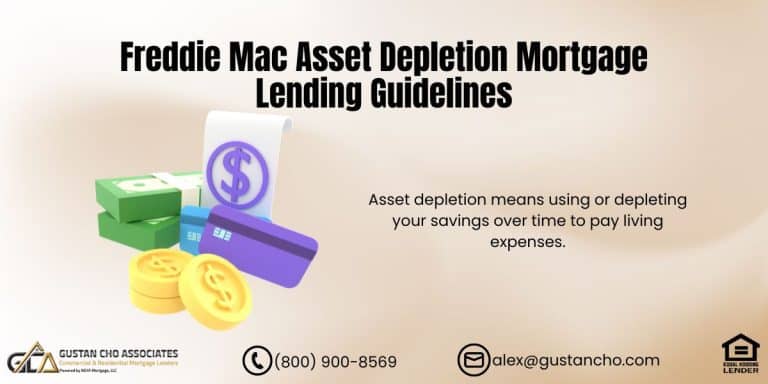Guide to Freddie Mac Mortgage Guidelines for 2024: Your Path to Homeownership or Refinancing
Are you ready to own a home or refinance your current mortgage but find all the mortgage terms confusing? Freddie Mac’s mortgage guidelines can be your solution! In this guide, we’ll break down everything you need to know about Freddie Mac’s guidelines for conventional loans. We’ll also cover the recent 2024 updates that may make qualifying and getting the loan terms you need easier.
What is Freddie Mac?
Freddie Mac, formally known as the Federal Home Loan Mortgage Corporation (FHLMC), is a government-sponsored enterprise (GSE) created in 1970 to support the U.S. housing market. Essentially, Freddie Mac doesn’t provide loans directly to borrowers. Instead, it buys mortgages from lenders, combines them, and sells them as mortgage-backed securities (MBS) to investors.
This process helps lenders offer more loans by freeing up their cash, ultimately making homeownership and refinancing more affordable and accessible for Americans.
Working with Freddie Mac-approved lenders allows you to access mortgage options with flexible terms, lower down payment requirements, and affordable interest rates. Whether you’re buying a new home, refinancing an existing one, or even interested in investing in rental properties, Freddie Mac’s conventional loan guidelines might be a fit for you.
Ready to Buy a Home? Understand Freddie Mac’s Conventional Loan Guidelines!
Contact us today to learn more about their guidelines and how you can qualify for a mortgage that fits your needs.
Is a Freddie Mac Loan a Conventional Loan?
Freddie Mac primarily works with conventional loans, which are different from government-backed loans like FHA or VA loans. Conventional loans follow set guidelines from Freddie Mac or Fannie Mae and generally require certain credit scores, down payments, and income levels.
Since the government doesn’t insure these loans, they typically come with more competitive interest rates but may require stronger credit and financial profiles. If you’re a borrower who meets Freddie Mac mortgage guidelines, a conventional loan could help you lock in an affordable rate and potentially save thousands over the life of the loan.
How Freddie Mac Mortgage Guidelines Benefit You
Choosing a mortgage backed by Freddie Mac has numerous benefits, including:
- Lower Interest Rates: By acquiring mortgages from lenders and providing mortgage-backed securities (MBS) to investors, Freddie Mac contributes to the stability of the housing market. This stability often results in reduced interest rates, which can save you thousands throughout the life of your loan.
- Flexible Underwriting Guidelines: Freddie Mac allows lenders to be flexible with various loan factors such as credit scores, debt-to-income (DTI) ratios, and income sources, making it easier for a broader range of borrowers to qualify.
- Wide Range of Mortgage Products: Whether you’re interested in buying a home, refinancing, renovating, or even purchasing a manufactured home, Freddie Mac has options designed to meet different needs.
- Support and Resources: Freddie Mac works with lenders, servicers, and community organizations to provide resources for borrowers who may need help managing payments, budgeting, and even avoiding foreclosure.
Freddie Mac Loan Programs and Mortgage Guidelines
Freddie Mac offers multiple loan programs designed to support diverse borrower needs. Let’s dive into some of the most popular options:
- Fixed-Rate Mortgages: These loans maintain a fixed interest rate throughout the duration of the loan, which typically lasts 15, 20, or 30 years. This provides the benefit of stable monthly payments, facilitating easier long-term budgeting.
- Adjustable-Rate Mortgages (ARMs): With ARMs, your interest rate may start low and adjust over time based on market conditions. These loans often have a fixed-rate period (e.g., five years) followed by adjustments. ARMs are popular among borrowers who anticipate refinancing or selling their home before the rate adjusts.
- Affordable Lending Programs (Home Possible and HomeOne): These programs are geared toward first-time homebuyers and low- to moderate-income families. They offer lower down payment requirements (as little as 3%) and more flexible credit guidelines.
- CHOICERenovation Loan: This option is perfect for homeowners looking to purchase or refinance and add renovation costs to one loan. It allows you to improve your home’s value without needing separate renovation financing.
- Enhanced Relief Refinance: This refinancing program is ideal for current Freddie Mac borrowers with little or no equity in their homes. It provides a streamlined option to lower monthly payments or change loan terms without the strict requirements of traditional refinancing.
- CHOICEHome Mortgage: This lending program provides attractive conditions for acquiring or refinancing manufactured homes. If you are looking to buy a manufactured home, this option considers it in the same way as site-built homes in terms of appraisal and interest rates.
Debt-to-Income Ratio (DTI) Limits for Freddie Mac Loans
Your DTI ratio is key when applying for a Freddie Mac loan. Starting in 2024, Freddie Mac typically adheres to the standards for Qualified Mortgages by the Consumer Financial Protection Bureau (CFPB), which limits the DTI to 43%.
However, exceptions may be allowed if you have compensating factors like a strong credit history or huge savings. Certain programs or loan scenarios may allow a higher DTI, so discuss your financial profile with your lender to explore all options.
Updates to Freddie Mac Mortgage Guidelines in 2024
Freddie Mac regularly updates its guidelines to keep homeownership accessible and affordable. Here are some of the latest changes that could benefit you:
- Cash Back for Rate-and-Term Refinances: Under Freddie Mac’s 2024 guidelines, cash received at closing on rate-and-term refinances has increased. Now, you may receive up to 0.50% of the loan amount (or $2,000, whichever is greater), which allows you to access additional cash from your loan without moving to a cash-out refinance.
- Student Loan Repayment Adjustments: If you’re on an Income-Based Repayment (IBR) plan, you may now qualify under new Freddie Mac guidelines that allow lenders to use your IBR payment amount rather than a higher calculated payment based on the loan balance. This adjustment can significantly reduce your DTI, potentially helping you qualify for more favorable loan terms.
- Self-Employment Income Guidelines: For borrowers with a primary full-time job and a side business, Freddie Mac will no longer penalize your overall DTI if your side business shows a loss. This update supports entrepreneurs by allowing them to separate side business losses from their main income stream when calculating DTI.
Confused About Freddie Mac Conventional Loan Guidelines? Let Us Help!
Contact us today to get expert advice on how to meet the guidelines and secure your mortgage.
Special Freddie Mac Programs for Unique Situations
Freddie Mac goes beyond conventional lending with niche programs tailored to specific borrower needs:
- HFA Advantage®: Available exclusively through Housing Finance Agencies, this program is tailored to low- and moderate-income borrowers. It offers reduced mortgage insurance, low down payment options, and flexible income sources, helping make homeownership more attainable.
- HeritageOne® for Native American Tribal Lands: This initiative enables individuals belonging to federally recognized Native American tribes to purchase or refinance a home situated on tribal land using specialized financing alternatives and adaptable underwriting.
- Community Land Trust (CLT) Program: Freddie Mac offers simplified appraisal requirements and favorable LTV (loan-to-value) ratios for borrowers interested in purchasing homes within a community land trust.
Understanding the Secondary Mortgage Market
Freddie Mac is important in the secondary mortgage market, as it purchases loans from lenders and packages them into mortgage-backed securities. Here’s a simple breakdown:
- Lenders Make Loans: Banks and lenders originate home loans for borrowers.
- Freddie Mac Buys the Loans: Freddie Mac purchases these loans, providing lenders with funds to make more loans.
- MBS Creation: Freddie Mac pools these loans into mortgage-backed securities and sells them to investors like mutual funds and insurance companies.
- Stability for Borrowers: This process stabilizes the mortgage market and helps keep rates affordable, making homeownership accessible to more Americans.
How to Submit an Application for a Freddie Mac Loan
Ready to apply? Here are the key steps to securing a Freddie Mac-backed loan:
- Research Lenders: Freddie Mac doesn’t lend directly to borrowers, so you’ll need to find a Freddie Mac-approved lender. Look for one specializing in the Freddie Mac program that best meets your needs.
- Evaluate Your Financial Profile: Check your credit score, DTI, and savings to determine what kind of loan you may qualify for. Many Freddie Mac programs are flexible with credit scores and down payments, so explore your options.
- Submit Your Application: Provide your lender with all required documentation, such as evidence of your income, assets, and liabilities. They will utilize this information to confirm your eligibility and identify the most suitable Freddie Mac loan option for you.
- Get Pre-Approved: Freddie Mac mortgage guidelines encourage pre-approval, showing sellers you’re serious and financially prepared. With pre-approval, you’ll also clearly understand your borrowing limits.
Achieve Your Homeownership Dreams with Freddie Mac
Whether buying your first home, upgrading, refinancing or even renovating, Freddie Mac offers a wide range of mortgage programs tailored to your needs. By understanding Freddie Mac’s guidelines and taking advantage of their flexible terms, you’re one step closer to achieving your homeownership goals.
For more details on Freddie Mac mortgage guidelines or to speak with a mortgage professional, contact one of our lending experts today. Call or text us at 800-900-8569 or email alex@gustancho.com. With the latest updates and programs designed to support borrowers, there’s never been a better time to explore your options with Freddie Mac!
Frequently Asked Questions About Freddie Mac Mortgage Guidelines:
Q: What are Freddie Mac Mortgage Guidelines?
A: Freddie Mac mortgage guidelines are the rules and standards lenders must follow for conventional loans. These guidelines cover credit score requirements, down payments, and debt-to-income ratios, helping borrowers qualify for loans with stable and affordable terms.
Q: How Does Freddie Mac Help Make Homeownership Affordable?
A: By purchasing mortgages from lenders and converting them into securities, Freddie Mac enhances the funds accessible for home loans. This action helps maintain lower interest rates, making it easier for borrowers to achieve homeownership.
Q: Is a Freddie Mac Loan the Same as a Conventional Loan?
A: Freddie Mac primarily deals with conventional loans, which the government doesn’t insure. Freddie Mac mortgage guidelines ensure these loans follow specific requirements to make homeownership accessible for qualified borrowers.
Q: What’s the Maximum Debt-to-Income (DTI) Ratio Allowed by Freddie Mac?
A: Typically, Freddie Mac allows a DTI of up to 43%. However, some exceptions can be made for borrowers with compensating factors, such as a strong credit history or substantial savings.
Q: Can I Get a Freddie Mac Loan with a Low Down Payment?
A: Certain Freddie Mac programs, such as Home Possible and HomeOne, permit minimal down payments, occasionally as low as 3%. These mortgage programs are for first-time homebuyers and individuals with moderate income levels.
Q: What Updates Have Been Made to Freddie Mac Mortgage Guidelines in 2024?
A: Recent updates include changes to cash-back rules on rate-and-term refinances, student loan repayment adjustments, and more flexible rules for self-employed borrowers. These updates aim to make qualifying easier and more affordable for borrowers.
Q: What Types of Mortgage Programs Does Freddie Mac Offer?
A: Freddie Mac offers various programs, including fixed-rate loans, adjustable-rate mortgages (ARMs), and options like CHOICERenovation for financing home improvements, all designed with Freddie Mac mortgage guidelines in mind.
Q: How Can Freddie Mac Guidelines Help Me if I’m Self-Employed?
A: As of 2024, Freddie Mac mortgage guidelines allow self-employed borrowers to exclude losses from side businesses when calculating their DTI if they also have a full-time job, making qualifying easier.
Q: Can I Refinance My Mortgage With Freddie Mac if I Have Little Home Equity?
A: Freddie Mac’s Enhanced Relief Refinance program is designed to help current Freddie Mac borrowers refinance even if they have little or no equity, often allowing for better terms and lower monthly payments.
Q: Where Can I Apply for a Loan That Follows Freddie Mac Mortgage Guidelines?
A: Freddie Mac doesn’t lend directly to borrowers. However, you can work with any Freddie Mac-approved lender to explore loan options and apply based on Freddie Mac mortgage guidelines.
This blog about “Freddie Mac Mortgage Guidelines on Conventional Loans” was updated on November 13th, 2024.
Freddie Mac Conventional Loans – Learn the Guidelines and Get Approved!
Reach out today to understand their guidelines and start the process toward homeownership.










